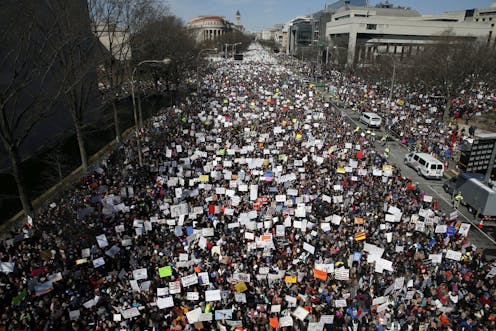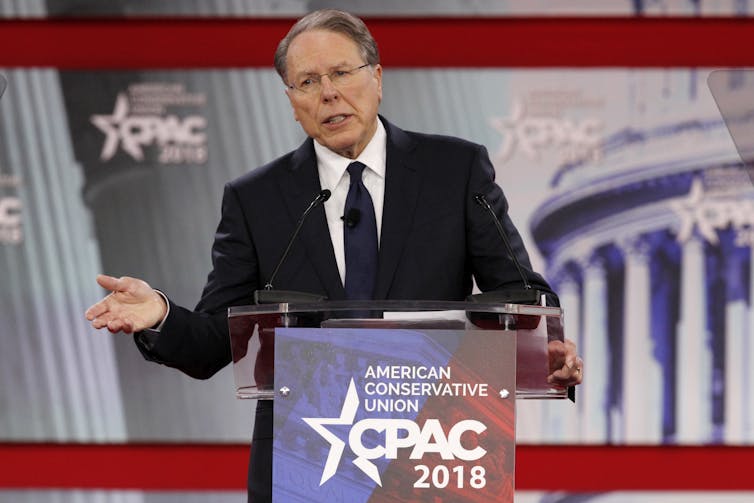Parkland shooting: One year later, Congress still avoids action on gun control
Despite impassioned pleas for gun control legislation after 2018's mass shooting at a Florida high school, Congress has failed to pass meaningful reform. Why doesn't policy follow public opinion?

One year after the deadly mass shooting at Marjory Stoneman Douglas High School, Florida and a handful of states have passed stricter gun laws, but little has changed with the federal government’s firearms policy.
Polls conducted after the Florida shooting showed that a majority of Americans supported stronger gun laws – including tighter restrictions on purchases and a ban on assault weapons – in the wake of the shooting.
Students demanded that elected officials “do something,” and many adults echoed that sentiment.
But policy does not always follow public opinion. Why are the public’s pleas on this and other issues ignored?
I’m a pollster and a political scientist who has examined the issue from different perspectives.
I’ve found three major reasons that policy does not always follow public opinion: the structure of the U.S. government, the overlooked complexities of public opinion and the influence of voters and interest groups.
Citizens don’t make policy
First, the United States is a republic, not a direct democracy. Citizens choose representatives who make policy decisions; citizens do not make those decisions directly. The Founders, who were not all fans of democracy and feared mob rule, established our governmental structure over 200 years ago, and those foundations remain today.
While about half the states have some form of initiative or referendum process to allow voters to directly enact policy, there is no such provision in the U.S. Constitution. And for those who advocate the repeal of the Second Amendment as a way to restrict gun ownership in the U.S., that’s not accomplished directly by citizens, either. Such changes would have to be voted on by elected representatives in Congress and legislatures across the country.
The composition and rules of Congress are also crucial, especially in the Senate, where each state has two votes. By design, this allocation of senators disproportionately represents the interests of less populous states.

So California and New York, the first and fourth largest states and ones that favor stricter gun laws, comprise about 18 percent of the population of the United States but only 4 percent of the senators. Alaska, Wyoming, Montana, North Dakota, South Dakota and Idaho, which tend to favor gun rights, comprise about 2 percent of the population and 12 percent of the Senate.
The House of Representatives, where each state is guaranteed at least one representative, also advantages lower-population states, albeit to a much lesser extent. The House is also subject to the partisan drawing of districts which has advantaged Republicans – who tend to support gun rights – since the 2010 Census.
The ubiquitous use of the filibuster, which can allow a Senate minority to block majority-supported legislation means most substantive legislation must get 60 votes in the Senate to pass. In a closely divided Senate, 60 votes are almost impossible to muster.
In addition, national sentiment is not mirrored in every state or congressional district.
Policy often doesn’t follow polling
Second: Polling and public opinion are not as straightforward as they seem. Focusing on only one or two poll questions can distort the public’s views regarding gun control.
Polling numbers generally show strong support for gun control measures such as universal background checks and an assault weapons ban.
Simultaneously, most Americans think that additional gun control measures won’t reduce violent crime. This is not surprising because most Americans don’t blame guns for these tragedies.
We should also keep in mind that gun control is not the only issue in which policy does not follow opinion. Other such issues include foreign aid and abortion.
And policy that reflects the “will of the people” may collide with legitimate legal constraints. Crafting legislation that disqualifies those we all agree should not possess firearms but protects the rights of law-abiding citizens is quite difficult.
For example, the American Civil Liberties Union opposed an order that would have prevented Social Security recipients with mental disabilities who have others managing their benefits from purchasing firearms. “Assault weapons” are difficult to define – and thus legally ban – because semi-automatic rifles can be used for hunting, too, as can AR-style rifles, although they are not commonly used for that purpose.
People vote, not polls
Finally, the influence of voters and interest groups can counteract the influence of the majority’s opinion in swaying policy.
Who votes matters. Gun owners are more likely than non-owners to vote based on the issue of gun control, to have contacted an elected official about gun rights, and to have contributed money to an organization that takes a position on gun control.
Such differing rates of political activity are to be expected because many gun owners fear their rights are or will be restricted, and that drives them to the polls. But the frequent appearances of gun control advocates in the news can lead to the erroneous impression that they are more passionate than gun rights supporters.

The National Rifle Association is a critical player in this discussion. In some ways a victim of its own success, the gun owners’ rights group is thought by many to have outsized power that it wields indiscriminately. In the last year, however, the organization’s finances and membership have diminished.
Its critics have called it a terrorist organization with blood on its hands and legislators who support gun rights have been referred to as “NRA-complicit bloody hannded (sic) mass murder enablers.”
At the major national annual conference for conservatives in February 2018, known as CPAC, NRA Executive Vice President Wayne LaPierre responded to that criticism by talking about a “socialist agenda.” He said NRA critics and “the elite” wanted to “eradicate all individual freedoms.”
The rhetoric is toxic, and both sides are guilty.
Whatever power the NRA possesses is a result of its membership and their votes. It claims approximately 5 million members, who pay attention to the group’s candidate ratings and generally vote accordingly.
Many others who are not members also agree with the group as evidenced by its consistent “favorable” ratings, typically measured in the 50 percent-plus range. Support for stricter gun laws typically increases after a mass shooting, but it tends to revert back to the trend line over time.
Elected officials want votes. There is no doubt that money is essential for political campaigns, but votes, not money or polls, are what determine elections. If a group can supply votes, then it has power. As such, the NRA is very powerful in some parts of the country and quite weak in others.
Many factors influence how legislation is drafted, amended, enacted and implemented. Searching for a direct causal connection from public opinion to specific policies, including gun control, may be akin to a search for the holy grail.
Our elected officials care more about the opinions of those who vote for them than what the nation as a whole thinks. On most issues they represent the interests of the majority of voters in their districts – or they get voted out of office.
This is an updated version of an article originally published on March 7, 2018.
Harry L. Wilson does not work for, consult, own shares in or receive funding from any company or organization that would benefit from this article, and has disclosed no relevant affiliations beyond their academic appointment.
Read These Next
Columbia president holds her own under congressional grilling over campus antisemitism that felled t
A rhetoric scholar says Columbia University President Nemat Shafik fared much better than her predecessors…
Graduation rates for low-income students lag while their student loan debt soars
Nearly half of all students who enroll in college never finish. Are colleges and universities to blame?
The tragedy of sudden unexpected infant deaths – and how bedsharing, maternal smoking and stomach sl
Rates of sudden unexpected infant deaths have not gone down significantly over the last 20 years, and…



